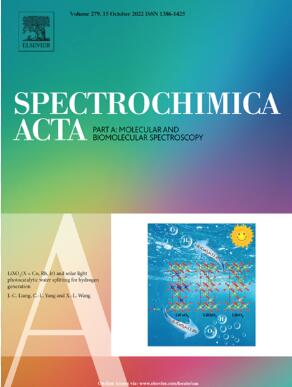A unique core–shell nanoreactor sSiO2@CeO2/Pt@mSiO2 as artificial nanozyme for ultra-sensitive detection of ascorbic acid and alkaline phosphatase activity
IF 4.3
2区 化学
Q1 SPECTROSCOPY
Spectrochimica Acta Part A: Molecular and Biomolecular Spectroscopy
Pub Date : 2025-05-22
DOI:10.1016/j.saa.2025.126459
引用次数: 0
Abstract
The core–shell nanoreactor with unique structure (such as a protective shell, a fixed or movable core, and the void space between the core and the shell) and adjustable function has attracted great attention in the field of catalysis. In this work, a novel core–shell nanoreactor sSiO2@CeO2/Pt@mSiO2 was designed and exploited as nanozyme in biosensing applications. The sSiO2@CeO2/Pt@mSiO2 demonstrated improved peroxidase-like performance on account of the unique structure and the synergetic effect between CeO2 and Pt. Based upon the peroxidase-like activity of sSiO2@CeO2/Pt@mSiO2, a colorimetric essay was developed for the ultrasensitive sensing of ascorbic acid (AA) owing to the excellent reducibility of AA. It was found that the absorbance of the oxidized TMB (ox-TMB) at 652 nm exhibited good linearity towards the concentration of AA in the range of 0–30 μM with the limit of detection as low as 16.4 nM. Furthermore, an enzyme cascade-triggered colorimetric reaction for the detection of alkaline phosphatase (ALP) was built on the basis of the excellent peroxidase-like activity of sSiO2@CeO2/Pt@mSiO2. ALP can catalyze the hydrolysis of AAP to produce AA, and the in situ generated AA can initiate the reduction of the ox-TMB produced in the system of sSiO2@CeO2/Pt@mSiO2-H2O2-TMB. The assay for the colorimetric sensing of ALP exhibited superior performance as compared to other methods with linear response of 5 × 10-4–1.4 U L-1 and lower detection limit of 9.3 × 10-4 U L- 1. This study not only provides a method to fabricate a nanozyme with high performance, but also offered a simply and ultrasensitive assay for the colorimetric analysis of AA and ALP.
一种独特的核壳纳米反应器sSiO2@CeO2/Pt@mSiO2作为超灵敏检测抗坏血酸和碱性磷酸酶活性的人工纳米酶
核-壳纳米反应器具有独特的结构(如保护壳、固定或移动的核以及核与壳之间的空隙空间)和可调节功能,在催化领域引起了广泛的关注。在这项工作中,设计了一种新型核壳纳米反应器sSiO2@CeO2/Pt@mSiO2,并将其作为纳米酶用于生物传感应用。由于独特的结构和CeO2与Pt之间的协同作用,sSiO2@CeO2/Pt@mSiO2表现出了更好的过氧化物酶样性能。基于sSiO2@CeO2/Pt@mSiO2的过氧化物酶样活性,由于AA的优异还原性,开发了一种超灵敏检测抗坏血酸(AA)的比色文章。结果表明,氧化TMB (ox-TMB)在652 nm处的吸光度与AA浓度在0 ~ 30 μM范围内呈良好的线性关系,检出限低至16.4 nm。此外,基于sSiO2@CeO2/Pt@mSiO2优异的过氧化物酶样活性,建立了酶级联触发比色反应检测碱性磷酸酶(ALP)。ALP可以催化AAP水解生成AA,而原位生成的AA可以启动sSiO2@CeO2/Pt@mSiO2-H2O2-TMB体系中生成的ox-TMB的还原。与其他方法相比,该方法具有较好的效果,线性响应为5 × 10-4 - 1.4 U L-1,检出限为9.3 × 10-4 U L-1。本研究不仅提供了一种制备高效纳米酶的方法,而且为AA和ALP的比色分析提供了一种简便、超灵敏的方法。
本文章由计算机程序翻译,如有差异,请以英文原文为准。
求助全文
约1分钟内获得全文
求助全文
来源期刊
CiteScore
8.40
自引率
11.40%
发文量
1364
审稿时长
40 days
期刊介绍:
Spectrochimica Acta, Part A: Molecular and Biomolecular Spectroscopy (SAA) is an interdisciplinary journal which spans from basic to applied aspects of optical spectroscopy in chemistry, medicine, biology, and materials science.
The journal publishes original scientific papers that feature high-quality spectroscopic data and analysis. From the broad range of optical spectroscopies, the emphasis is on electronic, vibrational or rotational spectra of molecules, rather than on spectroscopy based on magnetic moments.
Criteria for publication in SAA are novelty, uniqueness, and outstanding quality. Routine applications of spectroscopic techniques and computational methods are not appropriate.
Topics of particular interest of Spectrochimica Acta Part A include, but are not limited to:
Spectroscopy and dynamics of bioanalytical, biomedical, environmental, and atmospheric sciences,
Novel experimental techniques or instrumentation for molecular spectroscopy,
Novel theoretical and computational methods,
Novel applications in photochemistry and photobiology,
Novel interpretational approaches as well as advances in data analysis based on electronic or vibrational spectroscopy.

 求助内容:
求助内容: 应助结果提醒方式:
应助结果提醒方式:


